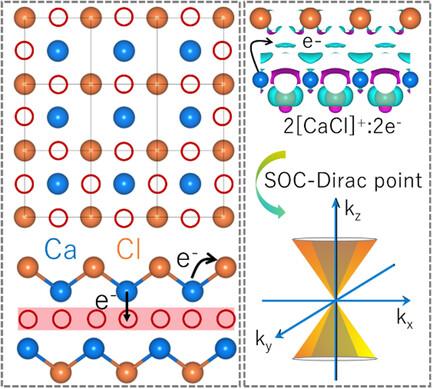Zero-Dimensional Interstitial Electron-Induced Spin–Orbit Coupling Dirac States in Sandwich Electride
IF 11.1
Q1 MATERIALS SCIENCE, MULTIDISCIPLINARY
引用次数: 0
Abstract
The development of inorganic electrides offers new possibilities for studying topological states due to the nonnuclear-binding properties displayed by interstitial electrons. Herein, a sandwich electride 2[CaCl]+:2e− is designed, featuring a tetragonal lattice structure, including two atomic lattice layers and one interstitial electron layer. The interstitial electrons form nonsymmorphic-symmetry-protected Dirac points (DPs) at the X and M points, which are robust against the spin–orbit coupling effect. DPs exhibit an approximately elliptical shape, characterized by a relatively high anisotropy, resulting from the interplay between the electron and atomic layers. In addition, 2[CaCl]+:2e− possesses a lower work function (WF) (3.43 eV), endowing it with robust electron-supplying characteristics. Due to the low WF and interstitial electrons, 2[CaCl]+:2e− loaded Ru shows outstanding catalytic performance for N2 cleavage. A potential research platform for exploring the formation of topological states and promoting nitrogen cracking in electrides is provided.

夹层氢化物中零维间隙电子诱导的自旋轨道耦合狄拉克态
由于间隙电子具有非核结合特性,无机电化物的发展为研究拓扑状态提供了新的可能性。在这里,我们设计了一种夹层电化物 2[CaCl]+:2e-,它具有四方晶格结构,包括两个原子晶格层和一个间隙电子层。间隙电子在 X 点和 M 点形成非非晶态对称保护的狄拉克点(DP),对自旋轨道耦合效应有很强的抵抗力。DPs呈现近似椭圆的形状,其特点是各向异性相对较高,这是电子层和原子层之间相互作用的结果。此外,2[CaCl]+:2e- 具有较低的功函数(WF)(3.43 eV),使其具有强大的电子供应特性。由于低功函数和间隙电子,2[CaCl]+:2e-负载的 Ru 在 N2 裂解过程中表现出卓越的催化性能。这为探索拓扑态的形成和促进电氧化物中的氮裂解提供了一个潜在的研究平台。
本文章由计算机程序翻译,如有差异,请以英文原文为准。
求助全文
约1分钟内获得全文
求助全文
来源期刊
CiteScore
14.00
自引率
2.40%
发文量
0
期刊介绍:
Small Science is a premium multidisciplinary open access journal dedicated to publishing impactful research from all areas of nanoscience and nanotechnology. It features interdisciplinary original research and focused review articles on relevant topics. The journal covers design, characterization, mechanism, technology, and application of micro-/nanoscale structures and systems in various fields including physics, chemistry, materials science, engineering, environmental science, life science, biology, and medicine. It welcomes innovative interdisciplinary research and its readership includes professionals from academia and industry in fields such as chemistry, physics, materials science, biology, engineering, and environmental and analytical science. Small Science is indexed and abstracted in CAS, DOAJ, Clarivate Analytics, ProQuest Central, Publicly Available Content Database, Science Database, SCOPUS, and Web of Science.

 求助内容:
求助内容: 应助结果提醒方式:
应助结果提醒方式:


